
The Louisiana Purchase Exposition, informally known as the St. Louis World's Fair, was an international exposition held in St. Louis, Missouri, United States, from April 30 to December 1, 1904. Local, state, and federal funds totaling $15 million were used to finance the event. More than 60 countries and 43 of the then-45 American states maintained exhibition spaces at the fair, which was attended by nearly 19.7 million people.

Washington University in St. Louis is a private research university with its main campus in St. Louis County, and Clayton, Missouri. Founded in 1853, the university is named after George Washington.
Charles Zeller Klauder was an American architect best known for his work on university buildings and campus designs, especially his Cathedral of Learning at the University of Pittsburgh, the first educational skyscraper.

Northwest Missouri State University is a public university in Maryville, Missouri. It has an enrollment of about 8,505 students. Founded in 1905 as a teachers college, its campus is based on the design for Forest Park at the 1904 St. Louis World's Fair and is the official Missouri State Arboretum. The school is governed by a state-appointed Board of Regents and headed by Interim President Clarence Green.

Collegiate Gothic is an architectural style subgenre of Gothic Revival architecture, popular in the late-19th and early-20th centuries for college and high school buildings in the United States and Canada, and to a certain extent Europe. A form of historicist architecture, it took its inspiration from English Tudor and Gothic buildings. It has returned in the 21st century in the form of prominent new buildings at schools and universities including Princeton, Washington University, and Yale.

Francis Olympic Field is a stadium at Washington University in St. Louis that was used as the main venue for the 1904 Summer Olympics. It is currently used by the university's track and field, cross country, football, and soccer teams. It is located in St. Louis County, Missouri on the far western edge of the university's Danforth Campus. Built in time for the Louisiana Purchase Exposition, the stadium once had a 19,000-person seating capacity, but stadium renovations in 1984 reduced the capacity to 3,300 people. It is one of the oldest sports venues west of the Mississippi River that is still in use. Francis Olympic Field now uses artificial turf that can be configured for both soccer and football.
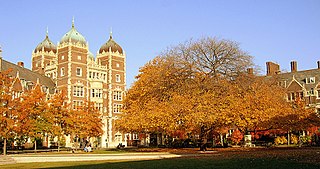
Cope and Stewardson (1885–1912) was a Philadelphia architecture firm founded by Walter Cope and John Stewardson, and best known for its Collegiate Gothic building and campus designs. Cope and Stewardson established the firm in 1885, and were joined by John's brother Emlyn in 1887. It went on to become one of the most influential and prolific firms of the late-nineteenth and early-twentieth centuries. They made formative additions to the campuses of Bryn Mawr College, Princeton University, the University of Pennsylvania, and Washington University in St. Louis. They also designed nine cottages and an administrative building at the Sleighton School, which showed their adaptability to other styles, because their buildings here were Colonial Revival with Federal influences. In 1912, the firm was succeeded by Stewardson and Page formed by Emlyn Stewardson and George Bispham Page.

Robert Somers Brookings was an American businessman and philanthropist, known for his involvement with Washington University in St. Louis and his founding of the Brookings Institution.

Washington University's origins were in seventeen St. Louis business, political, and religious leaders concerned by the lack of institutions of higher learning in the Midwest. The effort to found the university was spearheaded by Missouri State Senator Wayman Crow, and Unitarian minister William Greenleaf Eliot, grandfather of the Nobel Prize laureate poet T. S. Eliot. Its first chancellor was Joseph Gibson Hoyt. Crow secured the university charter from the Missouri State Legislature in 1853 and handled further political maneuvering. While Eliot was in charge of raising funds for the university, he accepted the position as President of the Board of Trustees. Early on Eliot was able to solicit some support from the local business community, including John O'Fallon, one of the wealthiest people in St. Louis, even briefly considering naming the university the O'Fallon Institute. However, Eliot failed in securing a permanent endowment. In fact Wash U is unique among other American universities, in not having any prior financial endowment to begin with; the school had no religious backing, wealthy patron, or government support. Therefore, financial problems plagued the university for several decades after its founding.

The Danforth Campus is the main campus at Washington University in St. Louis. Formerly known as the Hilltop Campus, it was officially dedicated as the Danforth Campus on September 17, 2006, in honor of William H. Danforth, the 13th Chancellor of the University, the Danforth family and the Danforth Foundation. Distinguished by its collegiate gothic architecture, the 169-acre (0.68 km2) campus lies at the western boundary of Forest Park, partially in the City of St. Louis. Most of the campus is in a small enclave of unincorporated St. Louis County, while all the campus area south of Forsyth Boulevard is in suburban Clayton. Immediately to the north across Forest Park Parkway is University City.

College Hill is a neighborhood of the City of St. Louis, Missouri. The name College Hill was given to this area because it was the location of the Saint Louis University College Farm. This area, bounded generally by Warne Ave., O'Fallon Park, I-70, Grand Boulevard, and W. Florissant Ave., was acquired by the University for garden and recreation purposes in 1836. It was subdivided in the early 1870s.
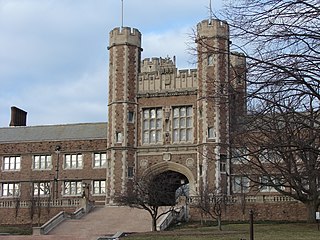
The Washington University Hilltop Campus Historic District was the site of the 1904 Louisiana Purchase Exposition and the 1904 Summer Olympics. Many of the exposition buildings were temporary in nature, but a number of permanent structures were built and are used by Washington University, which calls this area the Danforth Campus. The district includes more than fifty structures, of which twenty are in the Collegiate Gothic style.
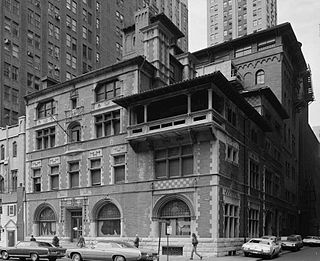
Frank Miles Day was a Philadelphia-based architect who specialized in residences and academic buildings.

The University of Missouri–St. Louis (UMSL) is a public research university in St. Louis, Missouri. Established in 1963, it is the newest of the four universities in the University of Missouri System. Located on the former grounds of Bellerive Country Club, the university's campus stretches into the municipalities of Bellerive, Bel-Nor and Normandy. Additional facilities are located at the former site of Marillac College and at Grand Center, both in St. Louis city.
Jamieson and Spearl was a St. Louis, Missouri architectural firm that designed most of the buildings built at Washington University in St. Louis and the University of Missouri in Columbia between 1912 and 1950.
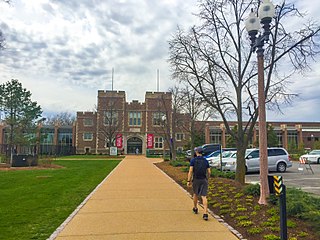
Francis Gymnasium is a building at Washington University in St. Louis, currently used by the university's athletics department. Built in 1903, it is located in St. Louis County, Missouri, on the far western edge of the university's Danforth Campus. It is part of the Washington University Hilltop Campus Historic District.

Albert Warren Kelsey, Jr. was an American architect, who designed in a number of Revivalist styles.

The Quadrangle Dormitories are a complex of 39 conjoined residence houses at the University of Pennsylvania, in Philadelphia, Pennsylvania, United States. The architectural firm of Cope and Stewardson designed the houses in an exuberant Neo-Jacobean version of the Collegiate Gothic style, and completed most of them between 1894 and 1912. The dormitories stretch from 36th to 38th Streets and from Spruce Street to Hamilton Walk. West of the Memorial Tower at 37th Street, the houses on the north side follow the diagonal of Woodland Avenue and form a long triangle with the houses on the south side. From 1895 to 1971, the dormitories housed only male students.
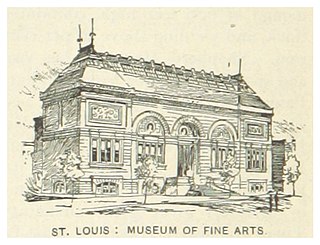
The St. Louis School of Fine Arts was founded as the Saint Louis School and Museum of Fine Arts in 1879 as part of Washington University in St. Louis, and has continuously offered visual arts and sculpture education since then. Its purpose-built building stood in downtown St. Louis on Lucas Place.



















